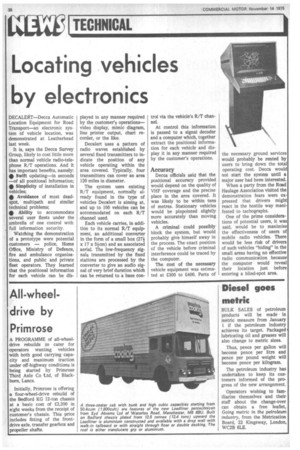Locating vehicles by electronics
Page 40

If you've noticed an error in this article please click here to report it so we can fix it.
DECALERT—Decca Automatic Location Equipment for Road Transport—an electronic system of vehicle location, was demonstrated at Leatherhead last week.
It is, says the Decca Survey Group, likely to cost little more than normal vehicle radio-telephone R/T operations. And it has important benefits, namely: • Swift updating—in seconds —of all positional information; • Simplicity of installation in vehicles; O Avoidance of most deadspot, multipath and similar technical problems; O Ability to accommodate several user fleets under the umbrella of one control with full information security.
Watching the demonstration of a prototype were potential customers — police, Home Office, Ministry of Defence, fire and ambulance organisations, and public and private fleet operators. They learned that the positional information for each vehicle can be dis played in any manner required by the customer's operations— video display, mimic diagram, line printer output, chart recorder, or the like.
Decalert uses a pattern of radio waves established by several fixed transmitters to indicate the position of any vehicle operating within the area covered. Typically, four transmitters can cover an area 120 miles in diameter.
The system uses existing R/T equipment, normally already found in the type of vehicles Decalert is aiming at, and up to 100 vehicles can be accommodated on each R/T channel used.
Each vehicle carries, in addition to its normal R/T equipment, an additional converter in the form of a small box (271 x 17 x 51cm) and an associated aerial. The low-frequency signals transmitted by the fixed stations are processed by the converter to give an audio signal of very brief duration which can be returned to a base con trol via the vehicle's R/T channel.
At control this information is passed to a signal decoder and a computer which, together extract the positional information for each vehicle and display it in any manner required by the customer's operations.
Accuracy
Decca officials said that the positional accuracy provided would depend on the quality of VHF coverage and the precise place in the area covered. It was likely to be within tens of metres. Stationary vehicles would be pinpointed slightly more accurately than moving vehicles.
A criminal could possibly block the system, but would probably give himself away in the process. The exact position cf the vehicle before criminal interference could be traced by the computer.
The cost of the necessary vehicle equipment was estimated at £300 to E400. Parts of the necessary ground services would probably be rented by users to bring down the total operating cost. Decca would not start the system until a major user had been interested.
When a party from the Road Haulage Association visited the demonstration fears were expressed that drivers might react in the hostile way manifested to tachographs.
One of the prime considerations of potential users, it was said, would be to maximise the effectiveness of users of mobile radio vehicles. There would be less risk of drivers of such vehicles "hiding" in the small areas having no effective radio communication because the computer would reveal their location just before entering a blind-spot area.




























































































































